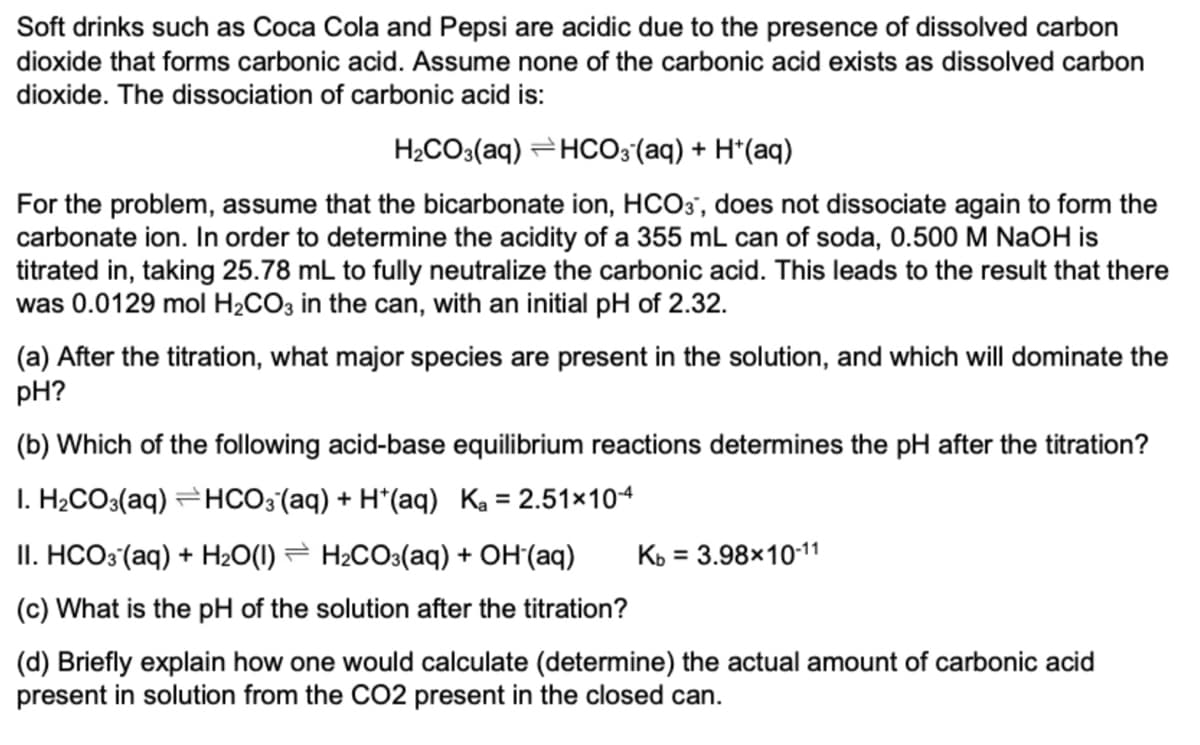Soft drinks such as Coca Cola and Pepsi are acidic due to the presence of dissolved carbon dioxide that forms carbonic acid. Assume none of the carbonic acid exists as dissolved carbon dioxide. The dissociation of carbonic acid is: H;COs(aq) =HCO3 (aq) + H*(aq) For the problem, assume that the bicarbonate ion, HCO3', does not dissociate again to form the carbonate ion. In order to determine the acidity of a 355 mL can of soda, 0.500 M NaOH is titrated in, taking 25.78 mL to fully neutralize the carbonic acid. This leads to the result that there was 0.0129 mol H2CO3 in the can, with an initial pH of 2.32. (a) After the titration, what major species are present in the solution, and which will dominate the pH? (b) Which of the following acid-base equilibrium reactions determines the pH after the titration? I. H2CO3(aq) =HCO3 (aq) + H*(aq) Ka = 2.51×104 %3D II. HCO3'(aq) + Hz0(1) = H2CO3(aq) + OH'(aq) %3D (c) What is the pH of the solution after the titration?
Soft drinks such as Coca Cola and Pepsi are acidic due to the presence of dissolved carbon dioxide that forms carbonic acid. Assume none of the carbonic acid exists as dissolved carbon dioxide. The dissociation of carbonic acid is: H;COs(aq) =HCO3 (aq) + H*(aq) For the problem, assume that the bicarbonate ion, HCO3', does not dissociate again to form the carbonate ion. In order to determine the acidity of a 355 mL can of soda, 0.500 M NaOH is titrated in, taking 25.78 mL to fully neutralize the carbonic acid. This leads to the result that there was 0.0129 mol H2CO3 in the can, with an initial pH of 2.32. (a) After the titration, what major species are present in the solution, and which will dominate the pH? (b) Which of the following acid-base equilibrium reactions determines the pH after the titration? I. H2CO3(aq) =HCO3 (aq) + H*(aq) Ka = 2.51×104 %3D II. HCO3'(aq) + Hz0(1) = H2CO3(aq) + OH'(aq) %3D (c) What is the pH of the solution after the titration?
Chemistry: Principles and Practice
3rd Edition
ISBN:9780534420123
Author:Daniel L. Reger, Scott R. Goode, David W. Ball, Edward Mercer
Publisher:Daniel L. Reger, Scott R. Goode, David W. Ball, Edward Mercer
Chapter18: Electrochemistry
Section: Chapter Questions
Problem 18.103QE
Related questions
Question

Transcribed Image Text:Soft drinks such as Coca Cola and Pepsi are acidic due to the presence of dissolved carbon
dioxide that forms carbonic acid. Assume none of the carbonic acid exists as dissolved carbon
dioxide. The dissociation of carbonic acid is:
H2CO3(aq) =HCO;(aq) + H*(aq)
For the problem, assume that the bicarbonate ion, HCO3', does not dissociate again to form the
carbonate ion. In order to determine the acidity of a 355 mL can of soda, 0.500 M NaOH is
titrated in, taking 25.78 mL to fully neutralize the carbonic acid. This leads to the result that there
was 0.0129 mol H2CO3 in the can, with an initial pH of 2.32.
(a) After the titration, what major species are present in the solution, and which will dominate the
pH?
(b) Which of the following acid-base equilibrium reactions determines the pH after the titration?
I. H;CO3(aq) =HCO3 (aq) + H*(aq) Ka = 2.51×104
II. HCO3 (aq) + H2O(1) = H2CO3(aq) + OH'(aq)
Кь 3D 3.98х1011
(c) What is the pH of the solution after the titration?
(d) Briefly explain how one would calculate (determine) the actual amount of carbonic acid
present in solution from the CO2 present in the closed can.
Expert Solution
Step 1
Since you have posted question with multiple sub-parts, we are entitled to answer the first 3 only.
Given: Moles of H2CO3 in the can = 0.0129 mol.
Volume of soda can used = 355 mL = 0.355 L
Volume of NaOH solution used = 25.78 mL = 0.02578 L
And HCO3- does not dissociate further to produce CO32-.
Trending now
This is a popular solution!
Step by step
Solved in 4 steps with 1 images

Knowledge Booster
Learn more about
Need a deep-dive on the concept behind this application? Look no further. Learn more about this topic, chemistry and related others by exploring similar questions and additional content below.Recommended textbooks for you

Chemistry: Principles and Practice
Chemistry
ISBN:
9780534420123
Author:
Daniel L. Reger, Scott R. Goode, David W. Ball, Edward Mercer
Publisher:
Cengage Learning

Chemistry: The Molecular Science
Chemistry
ISBN:
9781285199047
Author:
John W. Moore, Conrad L. Stanitski
Publisher:
Cengage Learning

Principles of Modern Chemistry
Chemistry
ISBN:
9781305079113
Author:
David W. Oxtoby, H. Pat Gillis, Laurie J. Butler
Publisher:
Cengage Learning

Chemistry: Principles and Practice
Chemistry
ISBN:
9780534420123
Author:
Daniel L. Reger, Scott R. Goode, David W. Ball, Edward Mercer
Publisher:
Cengage Learning

Chemistry: The Molecular Science
Chemistry
ISBN:
9781285199047
Author:
John W. Moore, Conrad L. Stanitski
Publisher:
Cengage Learning

Principles of Modern Chemistry
Chemistry
ISBN:
9781305079113
Author:
David W. Oxtoby, H. Pat Gillis, Laurie J. Butler
Publisher:
Cengage Learning

Chemistry: Principles and Reactions
Chemistry
ISBN:
9781305079373
Author:
William L. Masterton, Cecile N. Hurley
Publisher:
Cengage Learning

Chemistry & Chemical Reactivity
Chemistry
ISBN:
9781133949640
Author:
John C. Kotz, Paul M. Treichel, John Townsend, David Treichel
Publisher:
Cengage Learning

Chemistry & Chemical Reactivity
Chemistry
ISBN:
9781337399074
Author:
John C. Kotz, Paul M. Treichel, John Townsend, David Treichel
Publisher:
Cengage Learning